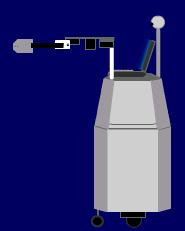Return to MODULE PAGE
Robots That Reason
David Leech Anderson: Author
What is it to "think" and to "reason"? Consider, for example, a math problem with multiple steps: 7 plus 23 divided by 5. You follow discrete rules that you have to consciously attend to or you are likely to make an error. There is also the kind or reasoning that one might do when trying to decide what college to attend. You might make a list of all of the factors that you consider relevant (cost, national reputation, quality of the faculty in your chosen field, proximity to friends and family, the "feel" of the campus, etc.) and then, as we say, you "weigh" all of the factors and make a rational choice. This kind of reasoning also qualifies as "higher cognitive functioning" because it requires a sophisticated analysis of the explicit "reasons" that one has for doing one thing rather than another. Yet this kind of reasoning is not as easily captured by an explict rule or even set of rules. We consciously focus our attention on each of the relevant factors in the decision, but then we just "make a judgment." If asked why we made the choice we did, we can often say little more than "it just seemed right, all things considered." This kind of mental processing, though it involves conscious reflection on the reasons for a decision, nonetheless has unconscious elements. We typically find it difficult to explain exactly why we made the choice that we did.
Our "reasoning" processes are complex, even puzzling. There is a high level of information processing going on, but how best can we understand the nature of that processing? To help us with that question, let's examine a couple of robots.
Why robots?
We are interested to explore human reasoning, the higher cognitive functioning that gives us some of our most distinctive abilities. But what could robots possibly have to do with that? So what if you could get a robot to speak English, do arithmetic, or respond appropriately to its environment? What would that show? It wouldn't necessarily show that the robot actually understood what it was doing, nor that it should be considered rational. And even if you believed that it did understand, it wouldn't necessarily teach us anything about how we perform those same tasks.
So why robots? Well, here's the point. Different types of robots can be used to model different types of information processing. Let's assume that you can build two robots that both simulate the some behavior -- behavior that would be considered "rational" if performed by a human being. Let's also assume that these two robots accomplish this "rational-like" behavior by very different means, using radically different ways of processing the information it receives from the environment. We could then ask:
Given what we know about human beings, which robot best captures the way that WE reason?
Admittedly, that is a hard question to answer -- especially for those of us who are not world-class experts in the cognitive and learning science. Even experts in the field do not agree about the correct answer to this question. It is, however, a fascinating controversy and one that can teach us some important things about current research on the nature of "reasoning". And robots can perform a valuable service as we study this topic.
The human brain is so darned complex that we can't begin to produce a detailed model of how the brain is able to "reason." We are still just beginning to unlock its mysteries. But one of the most important jobs of AI (artificial intelligence) programs and the robots that they control is to help us better understand some of the things that humans have figured out -- about the nature of different kinds of computers. The animated robots you will see are designed to help you better understand two different types of computers. Many scientists believe that "human reasoning" is best understood on the model of one or the other of the two computer models. But even if those people are wrong, these two computer models may, nonetheless, hold the key to unlocking the mystery of human reasoning. So, let's go explore some robots.
You are going to meet two robots. These are not physical robots, made of metal and silicon, they are animated robots that will operate right here on this webpage (assuming you have a recent enough Flash plug-in for your browser). Since we are interested in the kind of information processing that the two robots do and not their physical make-up, it doesn't really matter what their "bodies" are made of. We only need to know what they do with the information they receive from the environment. And that we will clearly see.

On the outside robots look the same. (They both look like the image to the right.) They both have a video camera that gives them information about their environment. They both have robotic wheels that move them about, and a robotic arm to pick up objects. Not only do they look the same, but they behave in a very similar way as well. It is there, however, that the similarity ends. They differ quite radically on the inside. For example, the information that they receive from the video camera is "represented" in different ways. Also, the procedures by which they "decide" how to behave are distinctly different. The best way to appreciate their differences is to see how each robot is constructed.
Meet the robots:
The PC (classical computer) Robot -- a symbol-processing model
The WC (water computer) Robot -- a connectionist model



